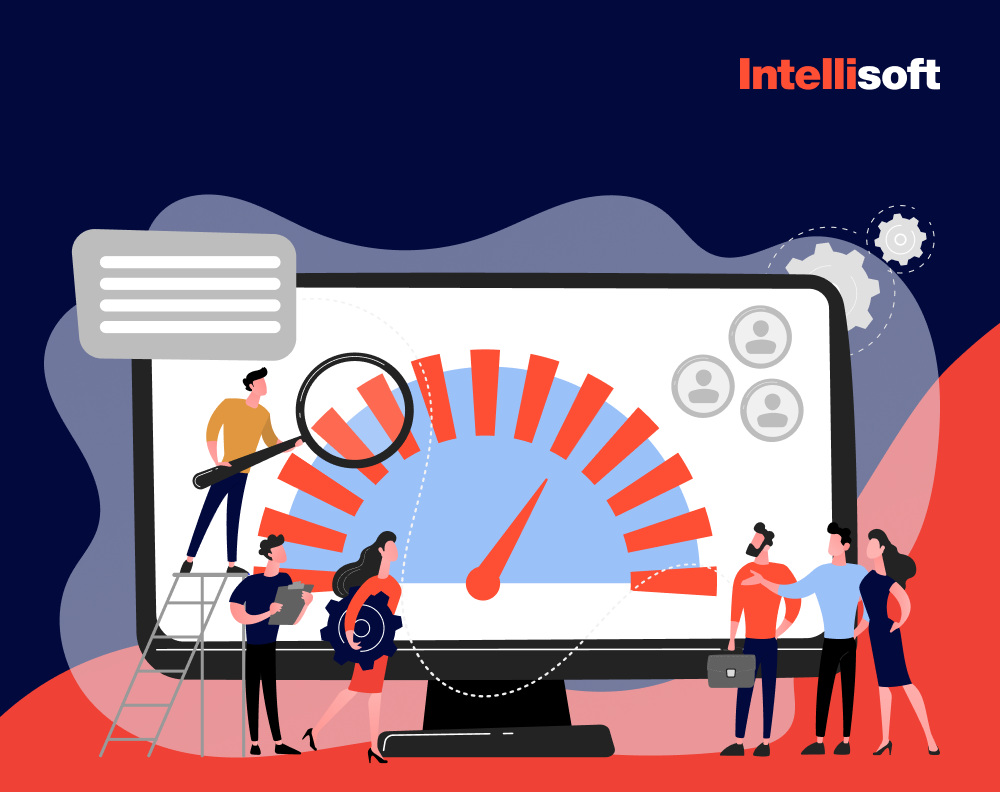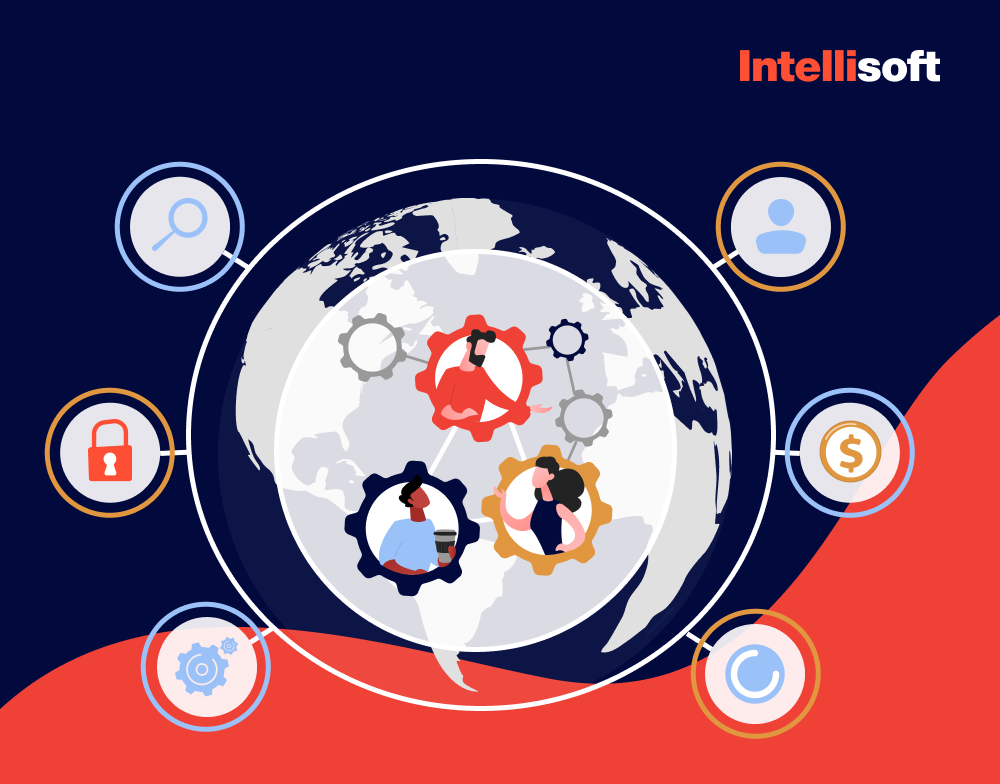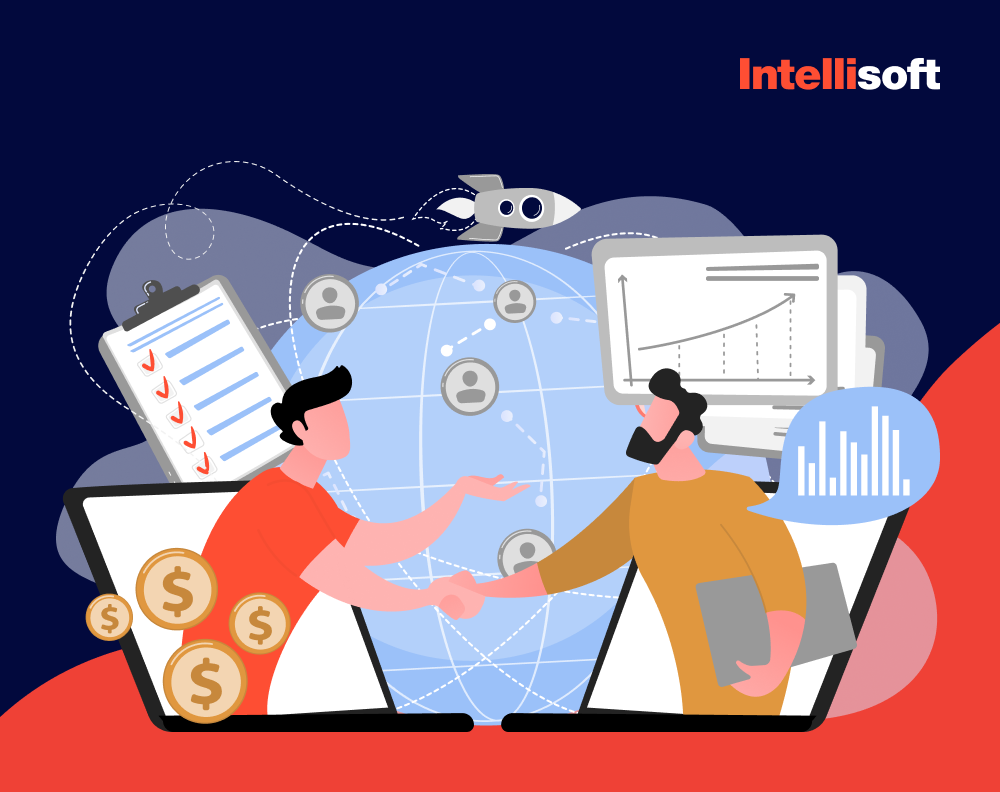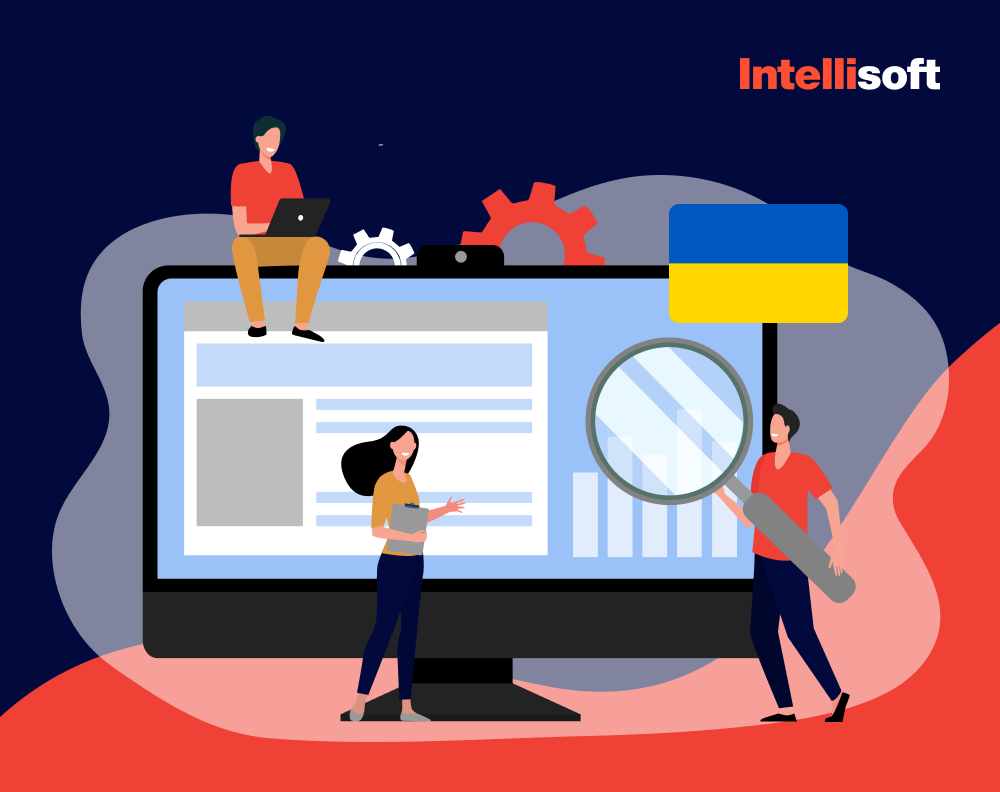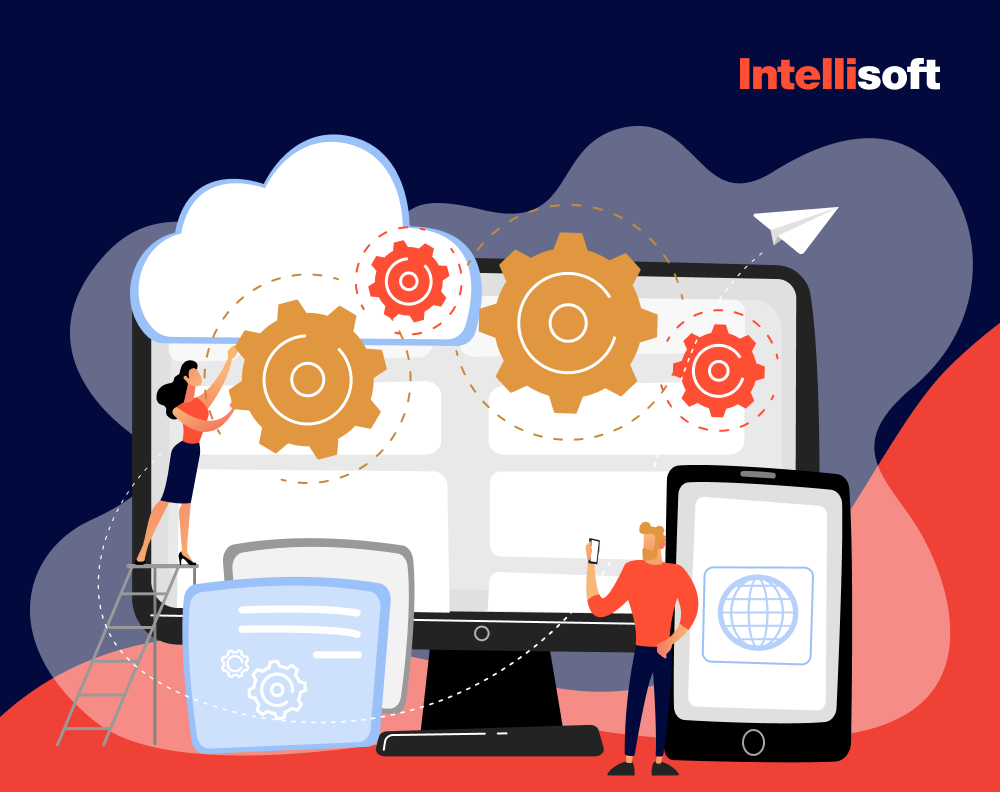Imagine yourself on a first date. There’s nervous anticipation, a buzz of excitement, and the hope that it leads to something wonderful. But what if, halfway through dinner, you realize your date is more interested in their phone than in you? It’s a classic case of mismatched expectations and a lack of due diligence. A similar situation can occur when you are selecting an outsourcing partner for your project.
That’s where vendor due diligence (VDD) comes into the picture. What is VDD? It’s a review process that can become your trustworthy friend who helps you in vetting your dates. In the tech world, VDD is like the groundwork before a big decision – selecting the right outsourcing partner. Think of it as swiping right on the most compatible match for your company.
We at IntelliSoft decided to create a guide on this topic and share our experience. We’ve been in the software development industry since 2007 and know exactly what makes an outsourcing partnership successful.
According to Statista, the global IT outsourcing market is on a meteoric rise, with an expected compound annual growth rate of 11.07%, reaching a staggering $777.7 billion by 2028.

It’s clear that the world is leaning towards outsourcing, and the stakes for choosing the right outsourcing partner have never been higher. We’ve seen the good, the bad, and the ugly, and we’re here to guide you away from common pitfalls and towards a prosperous collaboration without the awkward small talk of a first date, we promise!
Table of Contents
Understanding the Significance of Vendor Due Diligence
Have you ever wondered why some tech partnerships soar while others nosedive? The secret ingredient is often vendor due diligence (VDD). What is VDD? In layman’s terms, it is like a comprehensive health check-up for your potential tech partners. It’s a process that involves scrutinizing a vendor’s capabilities, stability, and suitability to ensure they’re the right fit for your project. Think of it as a detective’s investigation, where no stone is left unturned to uncover the truth about a potential outsourcing partner.
In the world of outsourcing software development, VDD becomes critical. Why? Because the tech industry is a dynamic beast. It’s constantly evolving and full of nuances. If you make the wrong choice, you can suffer from project delays, budget overruns, or even a complete project failure. VDD helps mitigate these risks by giving you a clear picture of whom you’re dealing with before you shake hands and dive into a project together.
Key Components and Stages of the Due Diligence Process
The due diligence process is multi-layered. Each stage must reveal more information about your potential partner. It typically involves several stages. During the initial screening, you skim the surface, looking at the vendor’s market presence, reputation, and initial capabilities. Now, it’s time to get serious. You perform in-depth analysis that involves a deeper dive into the vendor’s financial health, technical skills, process quality, and compliance standards. During your final evaluation, you can assess the cultural fit, negotiate terms, and finalize your decision.
Financial Due Diligence
Money talks, and in VDD, it speaks volumes. Financial due diligence is about understanding the vendor’s financial health and stability. Are they financially robust enough to support your project from start to finish? This stage aims to uncover any financial risks, assess the partner’s growth trajectory, and ensure a sound economic foundation for the collaboration. You can examine the vendor’s financial statements to understand their revenue streams and evaluate their financial resilience.
Legal Due Diligence
Here’s where you check if your partner is playing by the rules. Legal due diligence involves scrutinizing the vendor’s compliance with laws and regulations, their contractual obligations, and any potential legal risks. You need to make sure your potential partner doesn’t have any shady skeletons in their closet. You can review contracts, agreements, and intellectual property considerations. This step is crucial to avoid legal entanglements that could jeopardize your project.
Operational Due Diligence
Operational due diligence is all about how well the vendor can deliver on their promises. It involves evaluating their operational processes, technology infrastructure, and quality control mechanisms. Think of it as checking if your future partner can walk the walk, not just talk the talk. You can perform a detailed examination of their technology stacks, IT capabilities, disaster recovery plans, and overall operational robustness. This step is vital to ensure that the vendor can meet your project’s operational requirements efficiently.
Cultural Fit Assessment
Finally, the cultural fit. This is about aligning values and work ethics. A vendor might tick all the technical and financial boxes, but if they’re not on the same cultural wavelength as your company, the partnership could be rocky. This is like finding out if your date likes pineapple on pizza – a deal-breaker for some! Cultural fit assessment involves understanding the vendor’s corporate culture, work practices, and communication styles to ensure a harmonious relationship.
Vendor due diligence is a meticulous process that examines potential partners under a magnifying glass, assessing their financial, legal, operational, and cultural aspects. If you want to ensure that you choose the right partner who shares your vision, values, and business objectives, it is important to conduct thorough research. When it comes to tech outsourcing, conducting due diligence is crucial for a successful partnership. So, put on your detective hat and start investigating.
Steps in the Due Diligence Vendor Selection Process
Choosing the appropriate outsourcing partner is a critical factor in achieving success for your project. Each of the criteria must meet your requirements. Let’s dive into the steps of the due diligence vendor selection process that ensure you piece together a winning partnership.
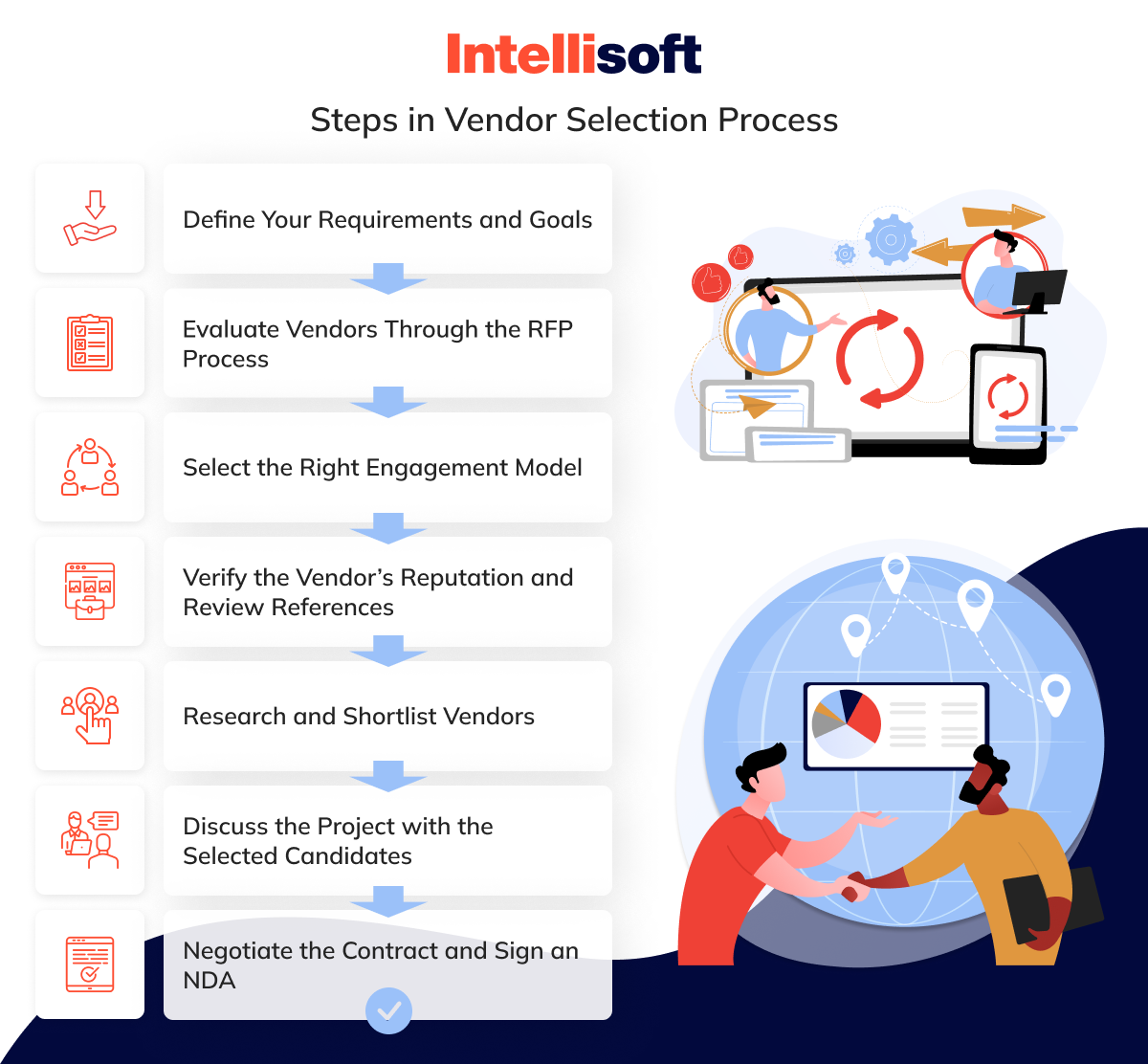
Step 1. Define Your Requirements and Goals
First things first, what’s your game plan? Defining your requirements and goals is like setting the destination on your GPS; it guides your journey. This step involves pinpointing what you need from your vendor – be it specific technologies, expertise in certain areas, or the capacity to handle large-scale projects.
First off, pinpoint the nature of your project. Is it a lean, feature-focused minimum viable product (MVP), a straightforward application, or a complex, ever-evolving software beast? Identifying this early on shapes your search for the ideal vendor, tailoring it to your project’s specific needs during the software selection journey.
Then, take a deep dive into your project’s scope. What’s the ultimate aim of your application, and what pivotal discussions need to happen with potential vendors? Don’t forget to factor in the necessary team and tech gear for a successful app development process.
Budgeting comes next. For compact projects with set-in-stone requirements, setting a budget is a walk in the park. But for larger, more fluid projects, budgeting becomes a dynamic adventure, demanding regular check-ins and tweaks.
Meeting deadlines is non-negotiable. In your hunt for a vendor, ensure they have a solid reputation for punctuality and consistently delivering top-tier work within agreed timelines.
Lastly, choose the model of the software development process that syncs with your project’s aims and demands – be it waterfall, incremental, agile, RAD, or another. Each model dances to its own rhythm and has its unique set of moves, making it crucial to pick the one that jives best with your project’s rhythm.
It’s crucial to be crystal clear about your project’s scope, objectives, and expected outcomes. This clarity streamlines the selection process and ensures you’re on the lookout for a vendor who can genuinely meet your needs.
Step 2. Select the Right Engagement Model
Choosing the right engagement model is like picking the right gear for a road trip. It needs to suit the terrain and the distance of your journey. In outsourcing, engagement models vary from project-based, where the vendor handles specific projects, to dedicated teams, where they provide ongoing support.
Dedicated Team Model
This approach establishes a long-lasting partnership where the IT vendor takes charge of forming and overseeing a dedicated software development team, complete with workspace and daily task management. Clients are billed monthly, covering team salaries, vendor fees, and administrative expenses.
Staff Augmentation or Outstaffing
Here, employees technically work under a client’s banner while remaining on the payroll of an external service provider. Essentially, the client “rents” these employees’ services from the provider and pays a fee for each team member involved.
Fixed Price Model
This project-specific pricing strategy sets the project’s scope, timeline, and costs upfront before development kicks off. The vendor offers a set price proposal to the client, with a payment schedule reflecting the project’s phases and duration.
Time & Material Model
In this billing approach, the client pays based on the daily rate of each specialist engaged in the project. To maintain transparency, detailed project reports accompany each invoice, updating the client on the progress.
The choice depends on your project’s complexity, duration, and flexibility requirements. Each model has its perks and pitfalls, so weigh them in relation to your project’s demands.
Step 3. Research and Shortlist Vendors
Now, it’s time to put on your detective hat. Research and shortlisting potential vendors is a critical step. It’s not just about Googling “best IT outsourcing vendors.” You need a strategic approach, considering factors like industry reputation, expertise in your domain, and technological capabilities. Create a list of potential partners who align with your requirements and goals. Here are the main criteria to pay attention to:
Evaluating Expertise and Qualifications
To streamline your selection, clarify your tech stack and skill set needs. Focus on vendors with a knack for technical abilities that enhance user experience and software integrity. Opt for those with a track record of handling projects akin to yours. Be wary of vendors claiming mastery over every tech field. Prioritize specialists who align with your specific technical needs.
Industry Experience Matters
The vendor’s industry experience is equally vital. Those skilled in your business area bring specialized knowledge invaluable to your project. While a vendor can learn about your sector, a swift project kickoff demands someone already versed in your domain. Evaluate their technical and industry understanding by exploring their history, client portfolio, projects, case studies, team resumes, blog posts, and event participation.
Considering Company Size
A vendor’s size influences their capacity to scale your development team. Medium to large vendors often boast broader resources and a wider talent pool, which is beneficial for larger or more specialized projects. Small vendors, however, may offer more tailored attention and adaptability. Align your choice with your project’s unique demands. Follow the “golden rule of 5%” – your project should represent between 5% and 20% of the vendor’s business, ensuring adequate focus on your needs.
Balancing Cost and Quality
Price is a key factor in due diligence vendor selection, but it shouldn’t be the only one. Temptingly low rates can lead to higher long-term costs due to inexperienced vendors causing delays, inadequate testing, frequent bug fixes, and subpar app development. Seek a balance between cost and quality. Aim for a vendor offering reasonable rates for high-quality work, supported by a solid track record.
Location and Communication: Key Considerations
In offshore outsourcing, location matters, but communication is paramount. The vendor should offer efficient communication platforms (like Skype or Slack), project tracking tools (Basecamp, Jira), and video conferencing apps (Zoom, Skype). Additionally, strong English proficiency and consulting skills are essential for clear interactions. For offshore outsourcing, consider destinations such as Ukraine, which is known for its robust IT services.
Gathering More Information
If you need deeper insights to narrow your choices, issue a “Request for Information” (RfI). This step will further clarify each vendor’s competencies and qualifications. Through diligent research, you can craft a list of vendors that meet your criteria and deserve your consideration.
Step 4. Evaluate Vendors Through the RFP Process
The Request for Proposal (RFP) process is where things get serious. It’s like a casting call where you get to see your potential partners in action. An RFP outlines your project requirements and asks vendors to propose their solutions.
Ensure your RFP encompasses these crucial components:
- An in-depth overview of your project’s needs and objectives.
- A clear outline of the expected work scope and specific deliverables.
- Defined project timelines and key milestones.
- Your budget or an estimated budget range for the project.
- Detailed technical requirements or limitations.
- Any pertinent policies or regulations that vendors must consider.
- Clear guidelines on response submission, including what details need to be in the proposal.
This is a crucial step that provides insights into vendors’ approaches, creativity, and problem-solving skills. Evaluate their responses carefully – the devil is in the details.
Step 5. Verify the Vendor’s Reputation and Review References
You wouldn’t buy a car without checking its history, right? Similarly, verifying a vendor’s reputation and reviewing references is absolutely vital. You need to examine their track record, client testimonials, and case studies.
Don’t hesitate to reach out to a prospective software development company, requesting contact details of product owners, project managers, or top-level executives from their previous and ongoing clients. The insights gained from their experiences can offer you a deeper understanding of the vendor’s operational methods, communication approach, quality of service, and cultural aspects. This step gives you a peek into the vendor’s reliability, quality of work, and client relationships.
Step 6. Discuss the Project with the Selected Candidates
Communication is key – it’s the bridge between expectations and reality. Discussing the project with selected candidates allows you to gauge their understanding of your project, their communication skills, and their enthusiasm. This dialogue can be quite revealing. It’s not just about what they say but how they say it. Are they asking the right questions? Do they offer insights or just nod along? These interactions are a litmus test for the potential of a fruitful collaboration.
A reputable software development company should be eager to showcase its technical prowess and propose the best solutions for your project. It’s wise to conduct technical interviews with the developers assigned to your project, evaluating not only their technical skills but also their fit with your team. If your organization isn’t technically inclined, consider bringing in a trusted external technical consultant.
After completing several interviews, you’ll likely have a shortlist of strong candidates. (Having more than one viable vendor option is beneficial as it provides alternatives and a contingency plan if your top choice falls through.) Often, these candidates may have similar qualifications and services. In such cases, elements like pricing and your overall impression of the vendor become crucial in determining your final choice.
Step 7. Negotiate the Contract and Sign an NDA
Finally, it’s deal-making time. By negotiating the contract and signing a Non-Disclosure Agreement (NDA), you’re sealing the deal. The contract should outline the scope of work, deliverables, timelines, payment terms, and any other critical aspects of the partnership. The NDA, on the other hand, ensures that your confidential information stays protected. This step is setting the ground rules for your partnership.
You can also sign additional documents:
- Intellectual Property Rights document solidifies your ownership of the code, product, designs, and documentation through a definitive agreement with the vendor.
- Non-Employment Agreement (NEA) protects against the recruitment of each other’s staff.
- Data Privacy Assurance guarantees your data’s safety and security with the vendor throughout all phases of the project, encompassing both data exchange and storage.
Selecting an outsourcing vendor is a process that demands attention, diligence, and strategic thinking. In outsourcing, selecting the right partner can make or break a project. So, take these steps seriously, and you’ll be well on your way to forging a successful partnership.
The Vendor Due Diligence Questionnaire: Your First Date with a Vendor
It’s time to start a new vendor relationship. You feel like you’re going on a first date. You’re curious, a bit wary, and you’ve got a ton of questions. The vendor due diligence questionnaire is your toolkit for this encounter, designed to probe beneath the surface and reveal the true nature of your potential partner.
Crafting the Perfect Set of Questions
Creating an effective vendor due diligence questionnaire is like preparing for an in-depth interview – you need the right questions to unlock meaningful insights. Here are some tips:
- Be specific. General questions get general answers. Aim for specificity to extract valuable information.
- Mix it up. Combine open-ended questions with specific queries. While open-ended questions gauge overall approach and philosophy, specific questions dig into technical and operational details.
- Cover all bases. Ensure your questionnaire spans all critical areas – from technical expertise and project management approaches, to security protocols and communication strategies.
- Keep it relevant. Tailor your questions to your project’s needs. Irrelevant questions dilute the focus and waste time.
- Invite honesty. Frame questions in a way that encourages candid responses, not just what you want to hear.
Vendor Due Diligence Questionnaire Example
- What technologies and tools do you specialize in? How do you stay updated with the latest tech trends?
- Describe your project management methodology. Can you explain your process for managing modifications to the scope of a project?
- What are your data security protocols? Can you explain the steps you take to make sure that you are following all the necessary rules and regulations that apply to your business or industry?
- What is your preferred mode of communication during a project? How do you handle communication across different time zones?
- How do you measure project success? Can you share examples of KPIs used in past projects?
- Could you provide an instance of a difficulty that you encountered while working on a past project? Please explain how you overcame it.
- How does your company culture align with client expectations? Can you provide an instance where this alignment benefitted a project?
We hope our vendor due diligence questionnaire example will help you prepare for your first meeting with your potential partner.
Reading Between the Lines: Evaluating Responses
Evaluating responses is not just about ticking boxes. You need to read between the lines.
Look for depth and detail. Generic responses are a red flag. Detailed answers demonstrate understanding and experience. Consistency is key. Watch for consistency in responses. Discrepancies could indicate a lack of clarity or honesty.
Practical examples matter. Responses backed by real-world examples carry more weight than theoretical answers. Note how they address cultural fit. It’s not just about technical fit but also about working harmoniously together. The way a vendor communicates in their responses can be reflective of their communication style throughout the project.
Red Flags to Watch Out For
- If a vendor is consistently vague in their responses, question their transparency and expertise.
- Unrealistic promises may be a sign of desperation or inexperience.
- Lack of customization in responses could indicate a rigid, inflexible approach.
- Avoidance of discussing past challenges or failures suggests a lack of honesty and a learning mindset.
- Slow response times may foreshadow future communication issues.
The VDD questionnaire is your first step in discerning whether a vendor is a match made in corporate heaven or a liaison best avoided. It’s your chance to ask the hard questions and get a sense of what a partnership would look like. A successful vendor relationship is built on transparency, alignment, and a mutual understanding of goals and expectations. So, take this first date seriously – it sets the tone for your future collaboration.
Common Mistakes to Avoid When Choosing an IT Outsourcing Partner
On your way to finding the ideal IT outsourcing partner, you may encounter some missteps. You need to be aware of some of the most common pitfalls to avoid regrettable experiences and increase the chances for a successful partnership.

Skipping Interview Process
Imagine choosing a new team member without an interview. Unthinkable, right? The same applies to selecting an outsourcing partner. The vendor interview is a crucial step in assessing their approach, capabilities, and alignment with your project needs. Skipping this process is like walking into a partnership blindfolded. It’s essential to engage in detailed discussions, ask probing questions, and gauge their problem-solving abilities firsthand. Remember, by buying a service, you’re entering into a relationship that demands mutual understanding and trust.
Lack of Proper Due Diligence
Performing due diligence is crucial in establishing a strong foundation for successful outsourcing partnerships. Neglecting this phase can lead to partnering with a vendor who may not have the necessary expertise, financial stability, or operational capacity. Proper due diligence involves evaluating the vendor’s past projects, financial health, client testimonials, and compliance with industry standards. It’s about ensuring they have the resources and commitment to meet your project’s demands, now and in the future.
Ignoring Service Quality
In the rush to cut costs or expedite processes, it’s tempting to sideline service quality. However, this oversight can be costly in the long run. Quality should never be compromised. A partner’s ability to deliver high-quality services is indicative of their expertise, efficiency, and reliability. Assess their quality assurance processes, check their certifications (if applicable), and understand their approach to maintaining high service standards. Remember, quality is not an area to cut corners – it’s an investment in your project’s success.
Not Assessing Scalability and Flexibility
Today’s business environment is constantly changing, making it crucial for your outsourcing provider to be able to adapt and scale effectively. Failing to consider a vendor’s scalability and flexibility can lead to bottlenecks and inefficiencies, especially as your project evolves. Assess whether the vendor can scale up (or down) their services as per your changing needs. Can they accommodate sudden shifts in your project without compromising on quality or timelines? Flexibility and scalability are key indicators of a vendor’s ability to handle the unpredictability of business demands.
Neglecting Communication and Collaboration
It’s hard to overstate the importance of effective communication and collaboration. Miscommunications and cultural misalignments can derail even the most well-planned projects. Ensure your vendor has reliable communication channels and tools in place. Evaluate their collaboration methodologies and their ability to integrate seamlessly with your in-house teams. Pay attention to language barriers, time zone differences, and cultural nuances. Project success requires effective communication and collaboration for transparency and alignment of expectations.
Avoiding common mistakes can foster a partnership that adds value to your business and contributes to project success. Remember, the right outsourcing partner is a strategic ally capable of transforming your vision into reality.
Overcoming Challenges in Vendor Relationships
Navigating the intricacies of vendor relationships in IT outsourcing can sometimes feel like you’re trying to find your way through a storm. It would be easier to do if you recognize the common challenges and implement effective strategies.
Common Challenges in Outsourcing
Outsourcing, while beneficial, comes with its set of challenges. The first step to overcoming them is to understand them better.
- Cultural and communication barriers come in the form of differences in language, time zones, and cultural norms. They can lead to misunderstandings and miscommunications.
- Ensuring that the outsourced work meets your standards of quality can be challenging, especially when dealing with complex projects.
- Differences in understanding project goals, timelines, and deliverables can lead to dissatisfaction.
- Sharing sensitive data with a third party carries inherent security risks, including data breaches and compliance issues.
- Over-reliance on a vendor or their inability to scale services as per your business growth can pose significant dependency and scalability issues.
Strategies for Overcoming Challenges
Ensuring successful outsourcing requires effective communication. Here are some strategies to enhance communication:
- Schedule frequent meetings to discuss project progress, challenges, and upcoming tasks.
- Maintain clear documentation in the form of detailed records of project requirements, changes, and agreements to avoid confusion.
- Leverage technology and use collaboration tools such as Slack, Zoom, or Microsoft Teams to streamline communication.
- Provide cultural sensitivity training. Educate your team and the vendor’s team about each other’s cultural norms and working styles to foster mutual respect.
- Define clear communication channels and hierarchy to ensure messages reach the right people efficiently.
Conflicts are inevitable in any relationship, including those with vendors. Here’s how to resolve them constructively:
- It’s important to identify any potential conflicts as early as possible and address them before they become bigger issues.
- Encourage an environment where issues can be discussed openly and without fear of reprisal.
- Approach conflicts objectively, focusing on finding solutions rather than placing blame.
- Strive for solutions that are acceptable to all parties, fostering a sense of collaboration and partnership.
- In cases of significant disputes, consider involving a neutral third party to mediate and provide unbiased solutions.
Overcoming the challenges in vendor relationships requires a proactive approach, focusing on clear communication, mutual understanding, and collaborative problem-solving. Implement these strategies, and you will be able to navigate these challenges effectively and maintain a healthy, productive outsourcing partnership.
Reasons to Hire IntelliSoft as a Software Development Partner
As you can see, choosing the right software development partner is pivotal to the success of your projects. As you might have guessed, we wanted to focus your attention on many reasons why IntelliSoft may stand out as the partner of your choice.
We streamline the typically lengthy recruitment process. A faster turnaround ensures you have top talent on board swiftly. At IntelliSoft, we don’t just focus on technological prowess; we ensure a cultural fit as well. Understanding your company culture allows us to integrate seamlessly as an integral part of your development team.
Here is a quote from one of our long-time clients, David Madie, the founder of GrowthWheel Inc.

Here is what our other client, Yaron Goldstein, CTO at ZyLab, had to say about our collaboration.
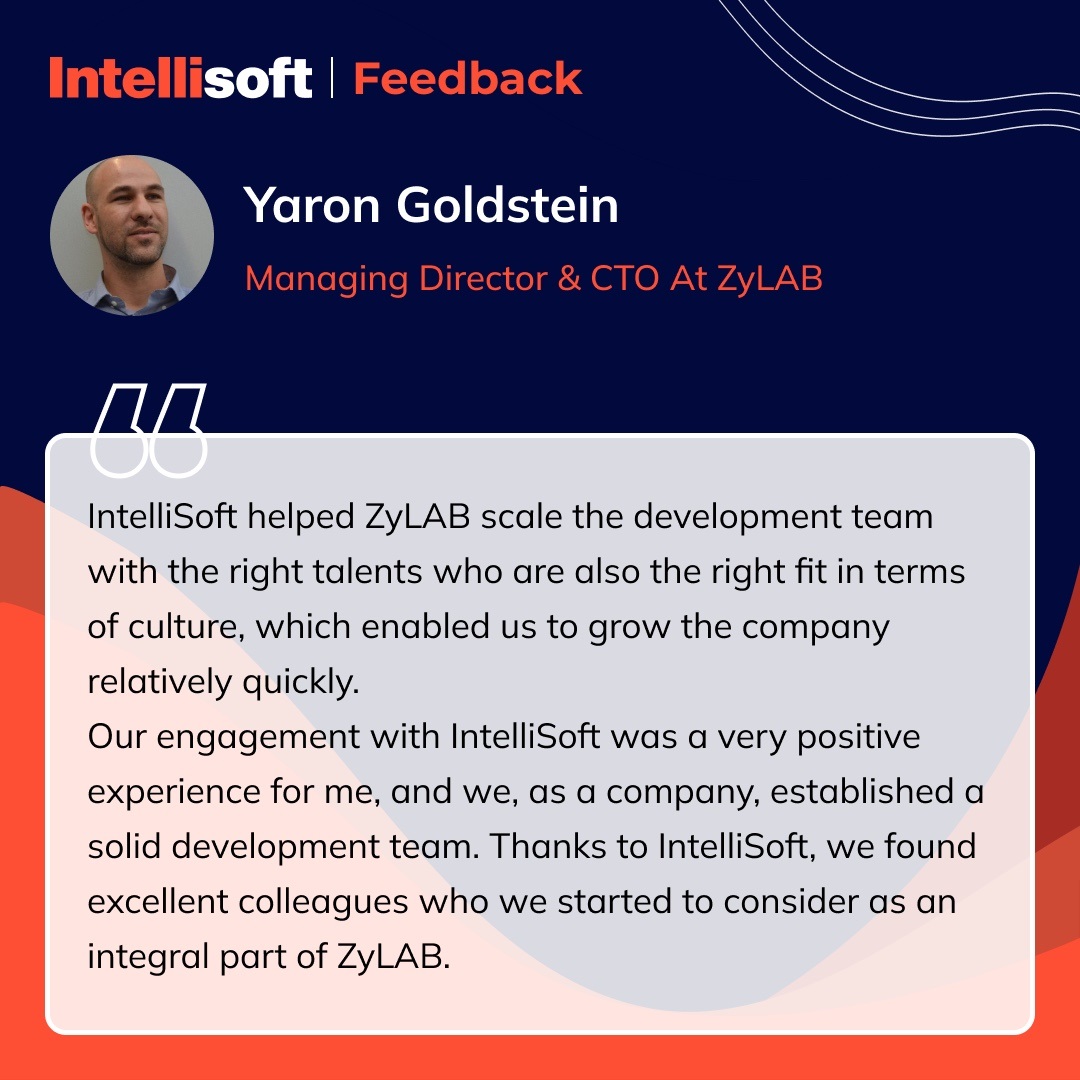
We excel in reading people, ensuring the candidates we choose align perfectly with your team’s culture and ethos. We never replace top talents with less experienced ones as the project progresses. Instead, we ensure that the developers hired for your team stay with your team, fostering consistency and reliability.
We’re invested in long-term relationships and emphasize retaining talent for your ongoing success. Our services extend beyond just recruitment. We excel in effective project management, ensuring that your team is always on track and productive.
Contact IntelliSoft to gain access to specialists whose skills and expertise are hard to find locally, especially at comparable costs. Developers at IntelliSoft tend to stay with your team for years. We value and nurture long-term client relationships, understanding that consistency is key to project success.
At IntelliSoft, we become a committed, integral part of your team. Our unique approach to recruitment, project management, and long-term partnership sets us apart, making us the ideal choice for your software development needs.


